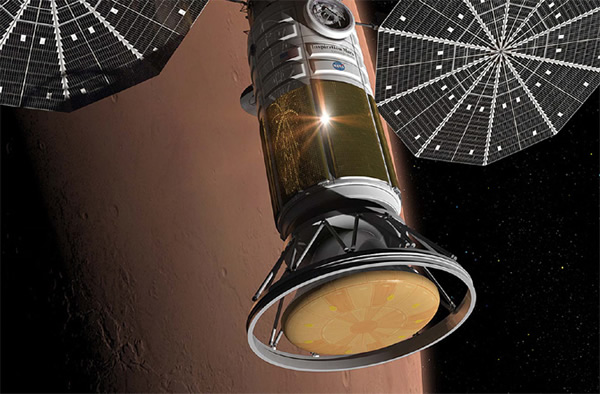NASA Support Needed for Private Mars Mission
An artist's illustration of the manned spacecraft for the Inspiration Mars mission to send two astronauts on a Mars flyby mission in 2017-2018.
A nonprofit space exploration group revealed today (Nov. 20) exactly how it plans to launch two married astronauts on an ambitious manned flyby mission to the Red Planet by early 2018, a scenario that would involve NASA and federal funding along with a healthy dose of the pioneering spirit.
The Inspiration Mars project — which is led by multimillionaire Dennis Tito, the world's first space tourist — hopes to partner with NASA, using much of the space agency's equipment and expertise as well as an infusion of federal money to get off the launch pad by early January 2018.
"Perhaps several hundred million dollars in new federal spending can make this mission happen," Inspiration Mars officials wrote in a report, released today, that outlines the mission's proposed architecture. "We now call on our nation’s leaders to seize this singular opportunity to begin human exploration of the solar system and affirm America’s leadership throughout the world."
The proposed "Mission for America" would launch a married couple toward the Red Planet sometime between Dec. 25, 2017 and Jan. 5, 2018, to take advantage of a rare favorable alignment of Mars and Earth.
The two astronauts would not land on the Red Planet but would cruise within 100 miles (160 kilometers) of its surface before heading back home, eventually touching down on Earth in May 2019 after spending 501 days in space.
The flyby mission will help inspire the next generation of researchers and engineers, preserving America's competitive edge in science and technology, Inspiration Mars officials say. It should also lay the foundation for even more ambitious manned exploration of the solar system, they add.
"There'll be a lot of science return and technology return," Taber MacCallum, Inspiration Mars' chief technology officer, told reporters during a teleconference today. "We will, I think, sort of break the sound barrier for going to Mars and back, enabling a range of missions to occur in the future."
The current mission plan, as outlined in the report, calls for using NASA's Space Launch System mega-rocket (SLS), which is in development with a first flight slated for late 2017.
The flyby mission would require two launches in quick succession. In the first liftoff, an SLS would loft four payloads to Earth orbit: an SLS upper-stage rocket; a 600-cubic-foot habitat module derived from Orbital Sciences' Cygnus cargo vessel; a service module that would support the habitat module with power, propulsion and communications systems; and an Earth re-entry pod, which would be based on NASA's Orion capsule.
The second launch — this one likely using a commercial rocket — would deliver the two astronauts to orbit aboard a yet-to-be-selected private spaceship. The crewmembers would then transfer to the habitat module, and the SLS upper stage would propel them on toward Mars.
The married couple would spend virtually the entire mission in the habitat module, transferring to the re-entry pod in the last few hours of the mission.
Inspiration Mars officials acknowledge that making all of this happen will be challenging. The re-entry pod, for example, will have to protect the astronauts from the blazing heat generated when it slams into Earth's atmosphere at about 32,000 mph (51,500 km/h).
But it can be done, and the current plan — which emphasizes the use of technology already proven or in development whenever possible — gives the mission the best chance of success, Inspiration Mars officials say.
"We submit this report with unreserved faith in the men and women of NASA, with a singleminded commitment to surmounting every obstacle, and with complete confidence that this mission can be done," they write in the report.(Nov 20, 2013 10:14 PM ET // by Mike Wall, Space.com)












